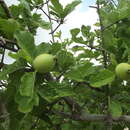Comprehensive Description
provided by North American Flora
Randia ehrenbergii Standley, sp. nov A densely branched shrub, the branch lets spreading, stout, subterete, rimose, ochraceous, the younger ones densely pilose with short, spreading or subappressed hairs, the branches bearing at the apex 3 or 4 stout pale spines 1 cm. long; stipules imbricate at the apices of the branchlets, glumaceous, 4-5 mm. long, pale, broadly ovate, subulate -mucronate, persistent, appressed-pilose outside; leaves short-petiolate, thick-membranaceous, opposite, densely crowded at the apices of the branchlets, the slender petioles 2-4 mm. long, densely pilose; leaf-blades rounded or broadly obovate, 1.2-3.5 cm. long, 1-2.5 cm. wide, rounded or very obtuse at the apex, acute or cuneately narrowed at the base, sometimes abruptly contracted near the base and decurrent, black when dried, glabrous above or at first sparsely hispidulous, when young densely hispidulous-hirsute along the veins and sometimes tomentose, soon glabrate, the slender costa elevated, the lateral nerves about 6 on each side, slender, inconspicuous, strongly arcuate, ascending at a broad angle, the lower ones approximate near the base of the blade; flowers dioecious; hypanthium narrowly campanulate, 3-3.5 mm. long, appressedpilose, the calyx-lobes oblong or linear, 1.5-2 mm. long, erect, obtuse or acute, remote; corolla obtuse in bud, glabrous outside, the tube thick, 13-14 mm. long, 2-2.5 mm. wide at the middle, strongly dilated above, 4 mm. broad in the throat, the lobes oblong-ovate, 7-8 mm. long, obtuse.
Frntex spinosus dense ramosus; folia parva breviter petiolata, lamina rotundata vel late obovata apice late rotundata vel obtusissima, basi acuta vel cuneato-angustata, supra glabra vel primo sparse liispidula, subtus statu juvenili praesertim ad venas hispidulo-hirsuta et interdum tomentosa, cito glabrata; flores dioeci. calycis lobis oblongis vel linearibus; corolla extus glabra, tubo crasso 13—14 mm. longo, lobis oblongo-ovatis obtusis tubo duplo brevioribus.
Type from Plan de Amilpas (Veracruz?), Mexico, March, 1831, C. Ehrenberg 575 (Herb. Berol.).
- bibliographic citation
- Paul Carpenter Standley. 1934. RUBIALES; RUBIACEAE (pars). North American flora. vol 32(3). New York Botanical Garden, New York, NY
Comprehensive Description
provided by North American Flora
Randia purpusii Greenm. & Thomps. Ann. Mo. Bot. Gard. 1:
410. 1915. Branches grayish or brownish, the branchlets very short and stout, leafy at the ends, densely whitish-pilose when young, bearing 2 or 4 spines at the apex, these stout, 3-10 mm. long, or wanting; stipules imbricate, broadly ovate, 2-3 mm. long, obtuse or acute, thin, brownish, sericeous outside, white-pilose within; petioles slender, 3-5 mm. long, pilose; leafblades mostly obovate or obovate-oblong, 1.5-5.5 cm. long, 0.8-2.3 cm. wide, long-attenuate at the base, acute or acutish at the apex, membranaceous, dark-green, densely short-pilose above, densely ^rayish-tomentose beneath, at least when young, the lateral nerves conspicuous, about 5 on each side, subarcuate, ascending at an acute angle; flowers terminal, sessile; hypanthium 1.5 mm. long, sericeous, the 4 calyx-lobes linear or linear-spatulate, 3-3.5 mm. long, sparsely pilose; corolla salverform, the tube 1.5 cm. long, sparsely pilose outside, the 4 lobes oblong-lanceolate, about as long as the tube; anthers subexserted, inserted in the corollathroat; ovules numerous.
- bibliographic citation
- Paul Carpenter Standley. 1934. RUBIALES; RUBIACEAE (pars). North American flora. vol 32(3). New York Botanical Garden, New York, NY

